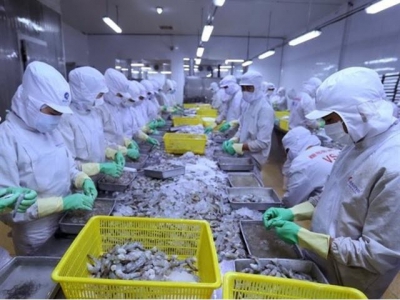Traceability requirements hinder local shrimp exports to EU

Ho Chi Minh City – Vietnamese shrimp exporters are having difficulty meeting the requirements on food safety and traceability when shipping their products to the European Union, according to experts at a conference in HCMC on Thursday.
Workers process shrimp at a plant in the Mekong Delta province of Hau Giang. Due to the small farming scale, shrimp exporters may find it hard to meet the traceability requirements of the European Union – PHOTO: VNA
Held by Oxfam and the International Collaborating Centre for Aquaculture and Fisheries Sustainability, the conference was aimed at starting a dialogue between stakeholders in the public and private sectors and discussing the opportunities and challenges arising from the European Union-Vietnam Free Trade Agreement (EVFTA) for Vietnam’s shrimp industry.
The greatest challenge is that most local producers are only able to run small shrimp farms, whereas the European Union demands shrimp exports meet stringent hygiene standards and obtain traceability certificates, creating high costs for these producers, stated Ho Quoc Luc, chairman of Sao Ta Foods JSC.
Other experts noted that expanding shrimp farms requires investment in science, technology and equipment. However, small-scale shrimp farming accounts for a staggering 70%-80% of the total, which makes it more difficult to meet the traceability requirement.
“To achieve this standard, breeding farms must have sufficient financial resources to meet the required investment, and their farming scale must be quite large to share the additional costs,” remarked Luc.
He added that the majority of local shrimp farmers lack capital and have little land. Therefore, the standard farming area only makes up some 5% of the total farming area.
Echoing a similar view, Pham Viet Anh of GlobalG.A.P pointed out that many households farm shrimp on a medium and small scale, and their farming methods are outdated, so they find it difficult to meet the requirements.
He noted that many shrimp breeders are still inclined to use antibiotics, though the amount used is starting to decline.
According to experts, shrimp exporters should form the habit of recording the history of their shrimp’s origins. None of them have any prior experience with this.
Importers will also require shrimp producers to take steps to protect the environment and safeguard the rights and interests of their workers.
Data from the Vietnam Association for Seafood Exporters and Producers (VASEP) show that shrimp, which accounts for nearly 38% of all seafood exports, recovered in July with a year-on-year increase of 13.4% to reach US$334 million after a weak performance since the beginning of the year.
In China, the government is applying trade barriers and increasing food safety control, so crossborder exports are not acceptable. However, official exports by sea are on the rise.
From June, the volume of white-leg shrimp exported by sea to China almost doubled compared with the previous month. VASEP forecast that this trend would continue to bring positive results for the remainder of the year.
By contrast, shrimp exports to the European Union fell by 21%. The main consumption countries, such as the United Kingdom, Germany and the Netherlands, recorded a drop of 5%, 9% and 45%, respectively. The average selling price dipped by US$1 per kilogram against the same period last year.
Related news
 Aquatic exports fall slightly, but imports edge up
Aquatic exports fall slightly, but imports edge up The import and export of aquatic products went into reserve during the first seven months of this year, noted the General Department of Vietnam Customs.
 Questions raised over cage culture's propensity to aggregate wild fish
Questions raised over cage culture's propensity to aggregate wild fish The use of open net pen farms has been questioned in a new paper looking into their impacts on wild fish populations.
 Seafood exports pick up but challenges continue
Seafood exports pick up but challenges continue Exports in the first seven months were worth US$4.7 billion, down 0.2 per cent from a year earlier, but 9 per cent up month-on-month in July.